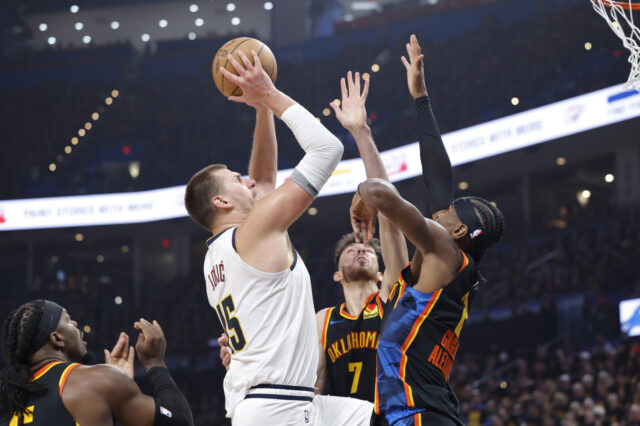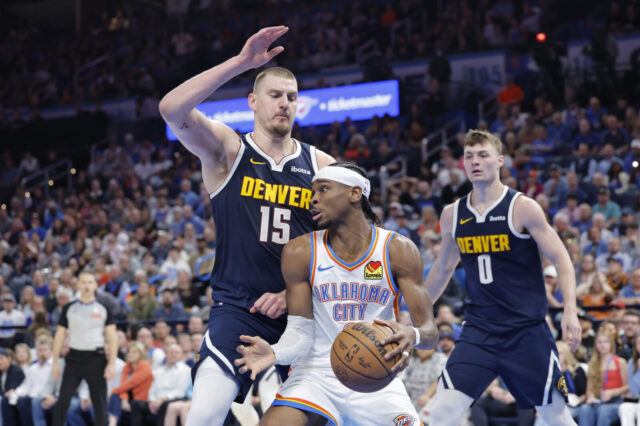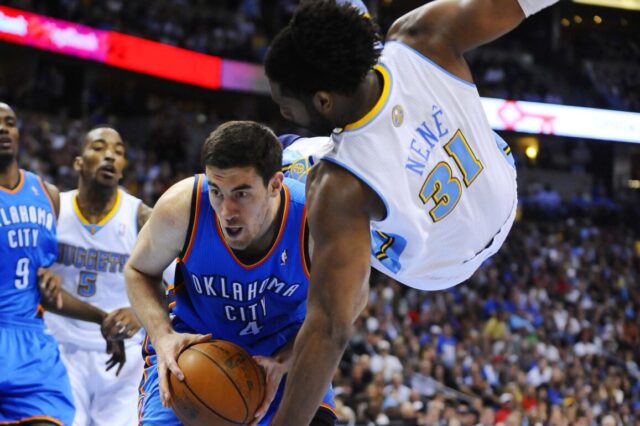One of the most difficult aspects of coaching for a team with winning expectations is trusting and committing to an unproven player.
There are rare high profile exceptions. Gregg Popovich has been coaching the San Antonio Spurs for a long, long time, and there was a time when he was forced to trust a young rookie point guard named Tony Parker. The French point guard was clearly an excellent talent, and the team’s previous starting point guard was a then 38-year-old Terry Porter. Popovich committed to the rookie Parker early, starting him every single game he played through a playoff exit to the Shaq-Kobe Los Angeles Lakers. That was the 2001-02 season, and the Spurs won a championship the next year, in part due to Popovich’s willingness to live through the rookie mistakes of Parker.
During the 2017 NBA Draft, the Denver Nuggets traded the 13th overall pick to the Utah Jazz in a move sure to draw grimaces and hisses as Nuggets fans read this sentence. The Jazz selected Donovan Mitchell, and he quickly became the first scoring option for a veteran team that needed him to step up as quickly as possible. Head coach Quin Snyder had to manage the rookie highs and lows, but it paid off with a high profile first round playoff victory over Russell Westbrook, Paul George, and the Oklahoma City Thunder. Mitchell has turned himself into a perennial All-Star and still has a higher ceiling to reach.
It’s tough to commit to a young player, and it can be even tougher when the decision isn’t blatantly obvious. For young players looking to fill roles, there are specific criteria coaches search for when building their rotations, and if a young player meets those criteria, they will play. If the player makes mistakes that lead to losses, it becomes justified for a coach to go with a veteran instead, even if the veteran isn’t a better player with as high of a ceiling. Coaches constantly worry about variance, and it’s consistency and good habits that often lead to those rotation decisions regarding a supporting role.
That leads to an extended discussion about rookie Bones Hyland and second year player Zeke Nnaji.
At 31-25, the Nuggets are probably slightly under expectations on the season. A long term injury to Michael Porter Jr. certainly reduced those overall expectations, and that was obviously unforeseen by Nuggets coaches and management. In his place, newly signed Jeff Green has stepped up and performed many of the functional duties Porter was asked to fulfill: defend opposing forwards, space the floor, cut off ball, and score when called upon. Green has done well, but he’s not Porter, who was expected to averaged upward of 20 points per game this season and likely to add seven to eight rebounds per game while shooting 40 to 45% from three-point range. It’s hard to replace that with just one player.
Along with the absence of Murray, the Nuggets main group had lost a certain amount of scoring dynamism. Their offense struggled to begin the year as Nikola Jokić and co. learned to live without the two elite scorers, and it was clear that both the starting and bench units needed a boost of sorts. The starting unit mostly stabilized on its own, but the bench has needed the impact of both Bones and Nnaji to help things out.
There have been ups and downs for each player, but on the whole, both have had successful seasons. Bones is averaging 17.8 minutes, 8.7 points, 2.7 rebounds, and 2.0 assists per game. He’s second among rookies with 500+ minutes with 24.2 points per 100 possessions, and his 24.2% usage rate also ranks third among the rookie class. The Nuggets have told Bones to be true to himself as a flamethrower of a shooter, and as a result, he’s averaging 13.7 threes attempted per 100 possessions. That not only leads the rookie class but ranks 11th in the entire NBA (500+ minutes played). His 34.6% three-point percentage could probably stand to improve, but it’s only his rookie season after all.
On the other side, Nnaji could probably look to steal some of Bones Hyland’s shooting aggression at times. The 6’9” power forward leads the entire NBA in three-point percentage at 48.7%, over two percent higher than any other player with as many attempts as him. Nnaji only attempts 5.8 threes per 100 possessions, and while his trigger discipline has helped his percentages remain exceedingly high, he’s still learning to let it fly whenever he’s in range, though on far fewer opportunities to do so than Bones. Nnaji isn’t just a shooter though. He’s averaging 16.7 minutes, 6.8 points, 3.7 rebounds, and has improved every single one of his numbers year over year. His defense has taken a leap as well, with him being trusted to guard many top options on the opposing team and doing so with success.
More than anything, the two young players have figured out how to be impactful next to Denver’s best player. Jokić is the be-all end-all in Denver, and learning how to be impactful next to him is a major step for a young player because it’s an entirely different brand of basketball from the bench unit.
So far, Bones and Zeke have done well in their limited opportunities. Let’s talk about each of them:
Bones Hyland
Recently, Bones has taken over at the point guard position for Denver. First, he was made the backup point guard behind Monte Morris as a better fit for the bench unit than Facu Campazzo. Then, Morris was forced to sit this past weekend while in concussion protocol, and Bones was inserted into the starting lineup to run point next to Jokić. His first matchup against the Boston Celtics mostly saw him operating off-ball. Against the Toronto Raptors the next night, he saw more playmaking opportunities.
Early on, Bones had several opportunities as a decision maker with the ball in his hands, and he was hit-or-miss. On this early shot clock possession, Jokić seals Scottie Barnes on the high side away from the rim, calling for an entry pass over the top of the defense. Bones sees the play and makes the pass on time, but it’s slightly errant, and Jokić doesn’t quite react in time to secure the ball before it sails out of bounds.
Dead-ball turnovers like the one above aren’t as bad as live-ball turnovers. The Nuggets can get back in transition, set their defense, and attempt to lock in on the subsequent possessions. In addition, passes like that show a good understanding of the situation at hand, and it’s up to Bones to execute the play as frequently as possible.
Bones makes up for it late in the fourth quarter as he finds the same basic pass over the top in a halfcourt setting, leading Jokić on a perfect pass to the front of the rim for an And-1.
But as good as Bones’ passing has proved to be in small doses, it’s his shooting in different contexts that has helped the Nuggets so much. Against the Celtics, he had some opportunities to navigate the mid-range area rather than space out to the three-point line, and he made the most of those shots off the dribble. Here, he’s fouled from behind by Jayson Tatum as he takes the shot available to him with Al Horford playing below the free throw line.
On the first play of the game against the Raptors, Bones receives a dribble handoff from Jokić on the right wing and curls around the screen for an easy floater over the help defender. The floater off a handoff set was a Jamal Murray (and Gary Harris) special that has only been carried on by Monte Morris of late. It was nice to see Bones take advantage of the skill and the open space.
Later in the game, the Nuggets are trying to feed Jokić in the post. Bones cuts from the strong side but is forced to relocate to the near side corner awkwardly after Jokić swings the ball to the corner. A less engaged player would have exited out of the lane opposite of Jokić like normal, and then Bones would have crowded the paint for Aaron Gordon’s residual drive. Instead, Bones finds the open space, calls for the ball, and cans the open three-pointer to close the half.
In another example of relocation late in the game, Bones acts like he’s going to set a screen for Jokić as a ball handler but makes the correct read to slip the screen to open space above the break. Fred VanVleet hangs around to try to bother Jokić, who couldn’t be less bothered, then passes the ball back to Bones. The rookie calmly hits the 29-footer to put the Nuggets up three with two minutes left on the road against the hottest team in the NBA.
Zeke Nnaji
Not to be outdone, Zeke Nnaji has also found an important role in lineups next to Jokić as a three-point specialist. Jokić operates in the middle of the floor, which means to some degree, the players around him orbit like a satellite. Nnaji is a great example. He isn’t often a creator of elite offense, but he certainly finishes plays well. He’s currently shooting 11-of-17 from three-point range when on the floor next to Jokić, good for 64.7%.
Elite shooters have a habit of being underrated and overrated at the same time. Teams often prioritize elite shooting role players because of players like Nnaji, where he can come off the bench and be an exceptional complementary for star players. He’s not going to rock the boat, and the limited opportunities he sees often see better results than other complementary players.
He also has elite efficiency compared to peers at his level of experience. Among all second year players in NBA history during the three-point era to play at least 500 minutes and attempt 75 threes, Nnaji’s 65.2% True Shooting ranks fifth behind Duncan Robinson, Juan Toscano-Anderson, Thomas Bryant, and Michael Porter Jr. (which is patently insane from MPJ).
Nnaji has replaced the high efficiency spacing of MPJ in a big way.
Sometimes, it’s as simple as Jokić finding him directly like in the possession above. Other times, Nnaji is the beneficiary of creative actions from Aaron Gordon, Will Barton, Monte Morris, and others as they freestyle with Jokić. Those games ensue, Nnaji’s defender is forced into help responsibility, and Nnaji becomes the open shooter after good ball movement, like the pass from Aaron Gordon below.
There are also flashes to Zeke’s game as a screener and cutter. When Jokić has the ball in his hands, Gordon and Jeff Green have perfected the flare screen and slip after a switch. Zeke seems to have been paying attention as well, and while it isn’t perfect looking, the result remains the same.
There are also the occasional flashes of Zeke expanding his game to attacking closeouts off the dribble. It isn’t something he tries often, but it’s a great counter when teams close out too hard on his outside shots. He’s athletic and coordinated enough that he should be able to take one dribble from the free throw line and take off with one hand more consistently. If not one dribble, then two dribbles and cramming a dunk on a poor center’s head is the next step for the 21-year-old forward.
Even more impressive than the offense has been the perimeter defense for Zeke. The athletic forward closed in place of Jeff Green against the Celtics in part due to his excellent perimeter defense. He matched up with Jaylen Brown on several occasions, and the star Celtics wing had nowhere to go on several possessions, including the below attempt at an isolation.
Before that, against the New York Knicks, Nnaji had perhaps his best individual defensive game of his career, bothering several drives and shots by Knicks bench players en route to one of Denver’s best bench performances of the entire season. His physical and athletic coverage on Obi Toppin was attention grabbing all night.
There are still clearly defined flaws for both Bones and Zeke that will probably preclude them from playing major roles for Denver this season. Bones is under 180 pounds, and his knowledge/execution of defensive schemes isn’t at a high enough level to make up for the size mismatch that often occurs under the rim. Zeke still struggles inside the arc at times, especially in a contested area where he has to either put the ball on the floor or fight through contact to make offensive and defensive plays.
Still, it’s clear that both have found ways to remain impactful within their roles.
Lineup Net Ratings for Denver’s young guys
- Bones + Jokić: 285 minutes, 114.8 Offensive Rating, 106.0 Defensive Rating, +8.8 Net Rating
- Nnaji + Jokić: 156 minutes, 122.8 Offensive Rating, 114.0 Defensive Rating, +8.9 Net Rating
- Bones + Nnaji + Jokić: 48 minutes, 110.5 Offensive Rating, 97.3 Defensive Rating, +13.2 Net Rating
The sample size is admittedly small, but it’s a good sign that Denver’s two most recent first round draft picks have helped contribute to legitimate success next to Jokić in the form of positive lineups. It gives Michael Malone confidence that those two players can be trusted in high leverage situations. Perhaps more importantly, it’s an indicator to President of Basketball Operations Tim Connelly that Bones and Zeke are potentially important contributors going forward.
In place of the injured Murray and Porter, the Nuggets have turned more and more frequently to their youngest players to fill the void in different ways. Bones doesn’t play through contact as well as Murray does, but he has many of the traits that make Murray a lethal scorer, including his ambitious shot making talent. Nnaji doesn’t have the same shooting trigger finger as Porter when he receives a pass from a teammate, but he makes the most of the open shots and makes up some of the difference on the defensive end.
When Murray and Porter ultimately return, it might signify a reduction in minutes for Bones and Zeke. Rather than go away entirely though, it’s possible that Malone can build on the progress and development both young guys have had and use them in addition to the two injured stars. The danger levels created by having multiple elite shooters out there at the same time could turn Denver’s offense from elite to unstoppable at times. And there’s no reason for the Nuggets to not learn more about their potential future, as all four of Murray, Porter, Bones, and Zeke are under contract through the 2023-24 season when Nnaji’s rookie deal expires. He will be a part of things going forward if things go well.
In the meantime, it’s a good thing that Denver’s two young guys are getting a crash course in Jokić offense. They’re hopefully going to need it for a long, long time.


